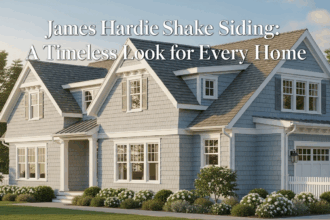Why Choose James Hardie Siding?
The Cost of James Hardie Siding in 2025 – Before delving into the numbers, it’s essential to understand the value proposition behind James Hardie products. This isn’t just an expense; it’s an investment in your home’s longevity and resilience. The material’s composition of cement, sand, and cellulose fibers makes it exceptionally resistant to common homeowner problems.
James Hardie siding is non-combustible, offering superior fire protection compared to vinyl or wood. It also resists damage from pests like termites and woodpeckers and will not rot, warp, or swell when exposed to moisture. This durability translates into lower maintenance requirements and a longer lifespan, contributing to its overall value.
The aesthetic versatility of James Hardie products is another major draw for homeowners. Available in a wide range of styles—from traditional lap siding to modern panels and rustic shingles—it can mimic the look of natural wood without the associated upkeep. Combined with a strong warranty and a high return on investment at resale, the initial outlay is often justified by its long-term benefits.

Understanding the Base Cost of James Hardie Siding in 2025
When planning your budget, it’s helpful to start with a baseline figure. For 2025, homeowners can anticipate the installed cost of James Hardie siding to range from approximately $12 to $25 per square foot. This broad range reflects the numerous factors that can influence the final price of your project.
To put this into perspective, let’s consider a typical 2,000-square-foot home. The total project cost could fall anywhere between $24,000 and $50,000. It is crucial to remember that this estimate includes both materials and professional installation, which is a significant portion of the total expense.
This price point is higher than vinyl siding but often competitive with or less expensive than high-end wood or brick. The key is that the cost of James Hardie siding reflects a premium product that offers superior performance. Understanding what drives this cost is the next step in creating an accurate budget.
Material Costs: The Product Lines
The specific James Hardie product you choose will have a direct impact on your material expenses. The company offers several distinct lines, each with its own price point. Examining these options is a key part of managing the overall cost of James Hardie siding.
The most popular option is HardiePlank® lap siding, which provides a classic, timeless look and is generally the most cost-effective choice in the lineup. For a more modern or commercial aesthetic, HardiePanel® vertical siding is an excellent option, though its price can be slightly higher. For adding character to gables or accent walls, HardieShingle® siding mimics the look of cedar shingles and typically comes at a premium price.
Furthermore, homeowners must choose between pre-primed siding, which needs to be painted after installation, or the more expensive ColorPlus® Technology. The ColorPlus® option features a factory-applied, baked-on finish that is incredibly durable and comes with a 15-year warranty against chipping, peeling, and cracking. While it increases the upfront material cost of James Hardie siding, it eliminates the immediate need for painting and reduces long-term maintenance.
Labor Costs: The Crucial Component
Labor is one of the largest and most variable components influencing the cost of James Hardie siding. Proper installation is critical to the performance and longevity of the product, and it is not a simple DIY project. James Hardie siding is heavier and more brittle than vinyl, requiring specialized tools and expertise to cut and install correctly.
Because of these requirements, it is highly recommended to hire contractors who are part of the James Hardie Contractor Alliance™ Program. These installers are trained and certified by the company, ensuring your siding is installed according to the manufacturer’s strict guidelines to validate the warranty. This expertise comes at a higher labor cost compared to general contractors or those primarily experienced with vinyl.
Regional differences in labor rates will also significantly affect your project’s total. A project in a high-cost-of-living urban area will naturally have higher labor expenses than one in a rural region. Always get multiple quotes from qualified local installers to get a precise understanding of labor’s contribution to the cost of James Hardie siding.
Project Scope and Size
The most straightforward factor in determining the total cost is the size of your home. The total square footage of the exterior walls that need to be covered will dictate the amount of material required and the hours of labor needed. A larger, two-story home will inherently cost more than a small, single-story ranch.
However, the complexity of the architecture also plays a significant role in the cost of James Hardie siding. Homes with numerous corners, gables, dormers, and complex window layouts require more precise cuts and detailed work, which increases installation time and labor costs. Conversely, a simple rectangular home will be quicker and more affordable to side.
Your project quote should detail the total square footage being covered. Be sure to discuss how architectural features might impact the labor estimate with your contractor. This ensures there are no surprises when it comes to the final invoice.
Key Factors That Influence the Final Cost
Beyond the base price of materials and labor, several other critical factors will shape your final invoice. A comprehensive budget must account for these variables, as they can add thousands of dollars to the project. Overlooking them can lead to unexpected expenses and financial strain. Acknowledging these elements is part of understanding the total cost of James Hardie siding.
The Condition of Your Existing Home
What lies beneath your current siding is a major unknown that can significantly impact the project’s cost and timeline. Before new siding can be installed, the old material must be removed and the underlying structure inspected. This process can reveal pre-existing issues that must be addressed.
The state of your home’s exterior walls is a primary consideration. Your contractor will need to assess the wall sheathing for any signs of damage. The cost of James Hardie siding can increase if repairs are needed before installation can begin.

Old Siding Removal and Disposal
The first step in a re-siding project is almost always the removal of the old cladding. This is an additional labor cost that will be included in your quote. The type of siding being removed can affect this cost; for example, heavy stucco or brick veneer may be more labor-intensive and expensive to remove than lightweight vinyl.
Once removed, the old materials must be properly disposed of, which incurs a disposal or dumpster rental fee. Some materials may require special handling, which could add to the expense. Make sure your contractor’s quote explicitly includes the cost of tear-off and disposal to have a complete picture of your project’s expenses.
Structural Repairs
After the old siding is removed, the contractor will inspect the home’s sheathing and framing for water damage, rot, or pest infestations. If any damage is found, it must be repaired before the new siding and weather-resistive barrier can be installed. This is a critical step to ensure the long-term integrity of your home.
The cost of these repairs can vary dramatically, from a few hundred dollars for a small patch of rotted sheathing to thousands for extensive structural work. It is wise to set aside a contingency fund of 10-15% of the total project cost to cover these potential unforeseen repairs. This contingency is a crucial part of planning for the true cost of James Hardie siding.
Geographic Location and Time of Year
Where you live has a considerable effect on the total cost of James Hardie siding. Labor rates, as previously mentioned, fluctuate significantly from state to state and even between urban and suburban areas. Additionally, material costs can be higher in regions farther from manufacturing and distribution centers due to shipping expenses.
The time of year you schedule your project can also play a role. The peak season for siding installation is typically spring and summer when demand is high, and contractors are busiest, potentially leading to higher prices. Scheduling your project during the slower fall or winter months might result in a more competitive quote, though weather can cause delays.
Maximizing Your Return on Investment (ROI)
While the initial cost of James Hardie siding is substantial, it’s important to view it through the lens of long-term value. According to Remodeling Magazine’s Cost vs. Value report, fiber cement siding replacement consistently ranks as one of the top home improvement projects for ROI. Homeowners can often recoup a significant portion of their investment upon resale.
This high ROI is driven by the enhanced curb appeal and the perception of a well-maintained, durable home. The low-maintenance nature of James Hardie products also adds value, as future owners know they won’t be burdened with frequent painting or repairs. This makes the cost of James Hardie siding a strategic investment in your property’s marketability.
Furthermore, when installed correctly with proper insulation and a house wrap, James Hardie siding can contribute to a more energy-efficient home. This can lead to tangible savings on your heating and cooling bills over the life of the siding. Thinking about these long-term savings helps contextualize the initial cost of James Hardie siding.
Conclusion: Budgeting for the Cost of James Hardie Siding in 2025
As we look toward 2025, the cost of James Hardie siding remains a premium investment for homeowners seeking durability, beauty, and lasting value. With an estimated installed cost of $12 to $25 per square foot, a full project represents a significant financial undertaking. However, this price reflects a superior product that offers unparalleled protection against the elements.
To budget accurately, homeowners must look beyond the base numbers and consider the full scope of their project. Factors such as product choice, home size and complexity, the condition of the existing structure, and local labor rates will all shape the final invoice. Careful planning, including a contingency fund for unexpected repairs, is essential for a smooth process.
Ultimately, installing James Hardie siding is more than an expense; it is a long-term investment in your home’s security, aesthetic, and market value. By obtaining multiple quotes from certified installers and understanding all the contributing cost factors, you can confidently plan for a project that will protect and beautify your home for decades to come. The final cost of James Hardie siding is a gateway to peace of mind and lasting quality.






